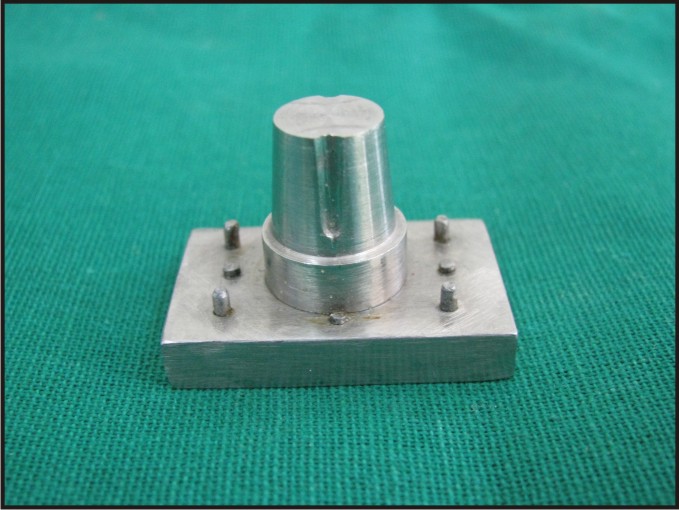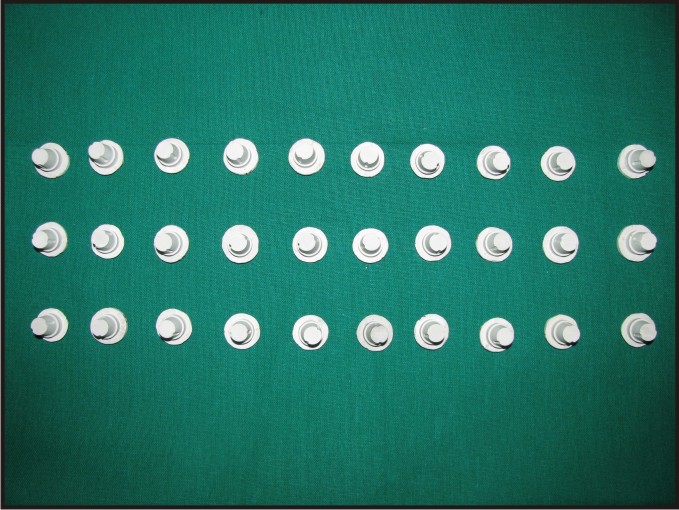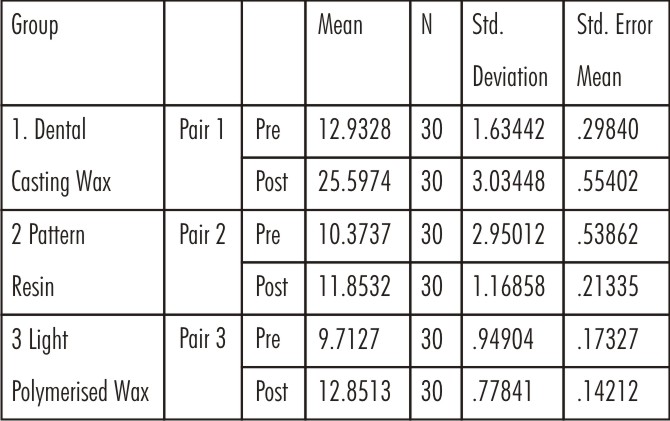Introduction:
Over the period of time, dentistry has evolved in perspectives, materials as well as technologies. In 1907,W. H. Taggart introduced “LOST WAX” technique to the dental profession.[1] Since then this technique has been employed for fabrication of metal castings. The procedure for making cast restorations have been so perfected over the years that casting failures must now be considered as an exception rather than a rule. The ability to produce sound and well-fitting castings routinely does however require strict adherence to certain fundamentals.
The key factor in deciding the success of the restoration is precise adaptation of the pattern to margin of the working die.[2] Marginal fit of the pattern is dependent on multiple factors amongst which the type of pattern material used for fabrication of the pattern is one of the deciding element for the success. Various materials have been tried for fabrication of patterns, with dental casting waxes having stood the test of time. However,the distortion of wax pattern during fabrication or during removal of the pattern from the die can create marginal discrepancy which has been attributed to relaxation of elastic stresses introduced during laboratory technique. To overcome the shortcomings of dental casting waxes, autopolymerizing resin was tried as a pattern material by Saunders in 1950.[3] It basically consisted of poly (methylmethacrylate) and an initiator. Autopolymerizing pattern resin materials offered strength, rigidity and dimensional stability but it exhibited polymerization shrinkage which is usually attributed to all the resins.
Previous materials utilized for preparation of patterns had certain shortcomings, so there has always been a drive to search for a material that fulfills most of the ideal requirements. This has led to introduction of Light Polymerizing Casting Waxes which are combinations of waxes and photo polymerized polymer. These materials have been extensively used for preparation of removable partial denture frameworks[4],[5] but there is inadequate technical and literature support that can prove the efficiency of these materials to fabricate the patterns for fixed restorations. Therefore it was necessary to check the utilization of Light Polymerizing Waxes for fabrication of patterns.
Taking these points into consideration, the purpose of this study was to compare the marginal discrepancies of patterns fabricated from Light polymerized casting waxes with commonly used pattern materials like Dental casting wax and Autopolymerized acrylic resin pattern material, so as to assess the efficacy of this material to fabricate the patterns for fixed restorations.
Materials And Methods:
For testing, a standardized stainless steel die with complete crown preparation was made with cervical diameter of 13 mm, 1.5 mm shoulder, 5 degree of uniform taper and height of 12 mm, two retentive grooves (1 mm depth) extending 2 mm short of finish line in accordance with various studies reviewed[6] (figure 1). Impressions of the master die were made in addition silicone by two stage putty wash technique. Impressions of the master die were then poured using Type IV dental stone to obtain 30 working dies for each sample. (Figure 2)
In this study total of three groups were made as follows (n= 30).
Group I: - Patterns fabricated using Dental casting wax [S-U WAX-A, Schuler Dental, Germany, Batch no. 6000006] (Figure 3)
Group II: - Patterns fabricated using Autopolymerized acrylic resin pattern material[Pattern Resin GC, Japan Batch no. 120901](Figure 4)
Group III: - Patterns fabricated using Light polymerized casting waxes[LiWa W+P Dental, Germany Batch no. WP5073] (Figure 5)
 | Fig. 1: Master Die
 |
 | Fig. 2: Working Dies
 |
 | Fig. 3: Dental Casting Wax
 |
 | Fig. 4: Autopolymerized Acrylic Resin Pattern Material
 |
 | Fig. 5: Light Polymerized Casting Wax
 |
Patterns were prepared on working dies by using bulk placementtechnique. Marginal discrepancy was then evaluated at four pre-marked points A, B, C, and D on working die and the readings were recorded as I (a), II (a) and III (a). The patterns were then removed from the working dies and replaced on the master die for measurements at same locations. Each pattern was seated on the master die and subjected to load of 50 gm for 3 minutes. The relatively small load of 50 gm was sufficient to overcome friction with the die while the pattern was seated but insufficient to cause deformation.[7] The marginal discrepancy between the metal die and the coping patterns were then measured in four quadrants at A’, B’, C’ and D’ and the readings were recorded as I (b), II (b) and III (b). This way two readings were made for each group; 1. Marginal discrepancy on the working die, 2.Marginal discrepancy on the master die.
These measurements were done as early as possible (within 2 hours) after pattern fabrication so as to reduce the effect of time factor on distortion. The patterns made with Dental casting waxes can be stored without noticeable distortion up to 30 minutes as stated by Phillips and Biggs[8] and up to 45 minutes as stated by Phillips. Thus, correlating above information on time dependent distortion of the pattern; care was taken to reduce the time elapsed between fabrication of the patterns and the measurements, as feasible.
Results:
Means and SD of the marginal discrepancies for the full-crown patterns for each pattern material are listed in Tables 1 and 2. Because of the minor importance of measurement location, the data were averaged for the four measurement locations on each of thirty dies to simplify interpretation of the results.
The ANOVA of the marginal discrepancies of the full crown patterns showed that all factors and interactions were significant at the 0.05 significance level as shown in Table 2. The marginal discrepancies ranged from 9 to 26μm.
 | Table 1
 |
 | Table 2
 |
Discussion:
The present study focused on investigating the marginal discrepancies of the patterns fabricated with Light polymerized casting waxes and to compare it with commonly used pattern materials like Dental casting waxes and Autopolymerized acrylic resin pattern materials. Introduction of newer materials in order to improve the quality of final restorations warrants a constant monitoring of the whole process to ensure success. Since the marginal fit of the crown is an important factor for their success, preliminary requisite of the materials used is that it should provide good marginal accuracy. Therefore, to quantify and compare the efficiency of this material with commonly used ones with respect to their marginal accuracy, the present study was designed.
As described in table I the Dental casting waxes showed marked marginal discrepancy as compared to the other two materials in both measurements.
The mean marginal discrepancy of patterns made with dental casting waxes on working die was 12.93 μm and on master die was 25.59 μm.Alan Iglesias2 (1996) in his study observed that marginal discrepancy of wax patterns were in range from 11 to 14 μm at the end of 1 hour and 15 to 23 μm at the end of 24 hours on the working die. The values in present study are in accordance with initial range of the above study.The mean marginal discrepancy of wax patterns on the working die and on the master die differed significantly. This could be explained by the fact as stated by Craig et al9 that the removal of the pattern from the working die and placement over the master die induces certain amount of stresses which contributes to increased value of marginal discrepancy on master die. Thus it can be said that removal of the pattern from the working die is a major contributing factor in altering the marginal accuracy of patterns fabricated from Dental casting waxes. Hence during manipulation of this material, repeated removal and checking of the pattern should be avoided to limit the distortion value.
The mean marginal discrepancy of the patterns made with Autopolymerized acrylic resin pattern material on working die was 10.37 μm and on master die was 11.85 μm. Alan Iglesias[5] (1996) in his study observed similar values of marginal discrepancy of pattern resin. They were in range of 10 μm to 11 μm at the end of 1 hour and 11 μm to 13 μm at the end of 24 hours on the working die. The values in both studies are in accordance with the present study.The values in present study are in accordance with this study. There was no considerable difference in the marginal discrepancy values of Autopolymerized acrylic resin pattern material obtained on the working die and the master die. This could be explained by the fact that the pattern resin sets by polymerization reaction which brings about the marginal discrepancy and once, the polymerization is complete there is no considerable change observed.
The mean marginal discrepancy of the patterns made with light polymerized casting waxes on working die was 9.71 μm and on master die was 12.85 μm. This material shows properties of waxes as well as resins which polymerize using visible light. The properties of wax as well as polymerization of the material brought about the observed values of marginal discrepancies on working die. The data obtained from the present study proved the better marginal adaptation of Light polymerized casting waxes at margins as compared to Dental casting waxes. However, marginal adaptations of Autopolymerized acrylic resin pattern materials and Light polymerized casting waxes were comparable. Removal of the pattern from the working die and placement over the master die induces certain amount of stresses which contributed to increased value of marginal discrepancy on master die that could be related to stress release factor of the wax components.
On comparing the observations made for the three materials it can be said that Light polymerized casting waxes and Autopolymerized acrylic resin pattern materials resulted in lesser marginal discrepancy as compared to Dental casting waxes. Even though, Dental casting waxes have shown the higher marginal discrepancy values as compared to other two materials, they continue to remain the mainstay for fabrication of the patterns for full crowns. Christensen (1966) in their study observed mean marginal discrepancy of the castings fabricated from patterns made with Dental casting waxes to be 120 μm. However, recent studies by Elaine R. Schilling et al[10] (1999) and Ossamu Ushiwata et al[11](2000) have shown lesser values in the range from 49 μm to 52 μm for marginal discrepancy of the castings. These could be attributed to constant improvisation in the field of material science and also laboratory techniques advocated.
Thus, within the limits of the study it can be said that Light polymerized casting waxes and Autopolymerized acrylic resin pattern materials are better materials for fabrication of pattern as compared to the conventional Dental casting waxes. These light polymerized casting waxes have shown promising results in utility as a pattern material. Hence it can be postulated that Light polymerizing casting wax can be considered as a viable material option and alternative to Dental casting wax in fabrication of the patterns.
This study was limited to assessment of marginal discrepancies at the pattern stage only bearing in mind the fact that Light polymerized casting waxes have yet not been tried for making fixed restorations. Thus it was thought of first analyzing and verifying its utility for making of patterns and comparing it to routinely used materials. However, further detailed studies are required to finally prove the efficacy of Light polymerizing casting waxes in Fixed Prosthodontics by investigating the fit and marginal discrepancies of the end product.
Conclusions:
Based on the results of the study, it was concluded that the marginal discrepancies of patterns fabricated from Light polymerized casting waxes were less as compared to Dental casting waxes but it was almost equivalent to Autopolymerized pattern resin.
References:
1. W H Taggart. A new and accurate method of making gold inlays. Dent Cosmos 1907; 49:1117-21.
2. Iglesias A, Powers JM, Pierpont HP. Accuracy of wax, autopolymerized and light polymerized resin pattern materials. J Prosthodont 1996; 5:201-205.
3. Saunders D. Pattern making direct method using Acrylic resin. Brit. Dental Journal 1953; 94:183-7.
4. Bortun C, Liliana Sandu, S. Porojan. Wax Up Failures in the Removable Partial Dentures Technology Using Light Curing Materials. European Cells and Materials 2006; 11:17-21.
5. Bortun C, LilianaSandu, S. Porojan. Using of light-curing waxes in the removable partial denture technology. Int Poster J 2007; 9: Poster 371.
6. Mahler D B, Ady A B. The influence of various factors on the effective setting expansion of casting investment. J Prosthet Dent 1963; 13:365-73.
7. Chassiel Zeltser, Israel Lewinstein, Rafael Grajower. Fit of crown wax pattern after removal from the die. J Prosthet Dent 1985; 53:344-49.
8. Phillips R. W., Biggs D. H. Distortion of wax pattern as influenced by storage time, storage temperature and temperature of wax manipulation. J Am Dent Assoc 1950; 41:28-37.
9. Craig R G, Eick J D, Peyton F A. Properties of natural waxes used in dentistry. J Dent Res 1965; 44:1308-16.
10. Elaine R. Schilling, Barbara H Miller, Ronald D. Woody, Amp W. Miller III, Martha E. Nunn. Marginal gap of crowns made with a phosphate-bonded investment and accelerated casting method. J Prosthet Dent 1999; 81:129-34.
11. Ossamu Ushiwata, João Vieira de Moraes, Marco Antonio Bottino, Eduardo Galera da Silva. Marginal fit of nickel-chromium copings with duplicated stone dies and disclosing agent. J Prosthet Dent 2000; 83:634-43.
|